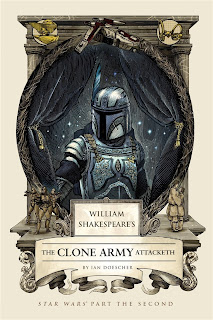Some of the best Star Wars literary tie-ins
 |
| (C) 2015 Quirk Books |
Since the late 1970s, so many Star Wars movie tie-ins have been published that they’d fill a Star Destroyer’s cargo hold. From novelizations of the screenplays to comic books, radio dramatizations, and even parodies, the publishing industry has given Star Wars fans different means to explore George Lucas’s original six-film space fantasy saga and Star Wars: The Force Awakens over the past 39 years.
With less than five months to go before the premiere of Disney/Lucasfilm’s Rogue One: A Star Wars Story, let’s explore the brightest shining stars of the Star Wars literary tie-in universe:
- Star Wars: From the Adventures of Luke Skywalker, George Lucas (ghost-written by Alan Dean Foster. Published by Del Rey in December 1976 with cover art by conceptual artist Ralph McQuarrie, Foster’s adaptation of Lucas’s fourth draft of the Star Wars screenplay gave the world its first peek of that galaxy far, far away. The novel sold moderately well before the film opened in May 1977. After Star Wars became a box office hit, the novel (with a new cover by John Berkey) was a runaway best-seller and has been reissued in various editions
- The Art of Star Wars, Carol Titleman (editor): Originally published in 1979, this trade paperback was the first book to contain Lucas’s complete screenplay for Star Wars - Episode IV: A New Hope. As the title implies, The Art of Star Wars is a treasure trove of poster art, production paintings, poster art, publicity photos, and costume designs from the first film of the Star Wars saga
- Star Wars: The Annotated Screenplays, Laurent Bouzerau: Ballantine’s Del Rey Books imprint published the screenplays to Star Wars: A New Hope, The Empire Strikes Back, and Return of the Jedi in a single volume to coincide with the trilogy’s 1997 Special Edition theatrical re-release. Bouzerau, a filmmaker who specializes in “making of” documentaries for laser discs, DVDs, and Blu-rays, dissects each script and describes how the movies evolved from story treatments to final shooting drafts.
- The Complete Star Wars Trilogy - The Original Radio Dramas, Brian Daley: Produced between 1981 and 1996, National Public Radio and Highbridge Audio’s audio adaptations of Star Wars; A New Hope, The Empire Strikes Back, and Return of the Jedi are among the most popular (and unusual) tie-ins to Lucas’s classic film trilogy. The late Brian Daley’s scripts delved deeper into the films’ backstories and gave the characters more depth and subtle nuances.
- William Shakespeare’s Star Wars Trilogy: Star Wars - Verily, A New Hope, The Empire Striketh Back, and The Jedi Doth Return, Ian Doescher: Between 2013 and 2014, Star Wars fan and Shakespeare lover Ian Doescher took a page from the parody novel Pride and Prejudice and Zombies and created a mashup of the works of George Lucas and the legendary Bard of Avon. Written in iambic pentameter and following the conventions of Shakespearean drama, William Shakespeare’s Star Wars series is a unique and worthy tie-in. A year later, Doescher completed his reimagined version of Lucas’s universe with a Shakespearean version of the Prequel Trilogy; Quirk Books published William Shakespeare’s The Phantom Menace: Star Wars Part the First in April 2015, The Clone Army Attacketh: Star Wars Part the Second in July, and The Tragedy of the Sith’s Revenge in November.
- Star Wars: The Prequel Trilogy, Terry Brooks, R.A. Salvatore, and Matthew Stover: This omnibus edition collects all three novelizations of Star Wars: Episodes I-III. Published in time for Star Wars’ 30th Anniversary in May 2007, The Prequel Trilogy chronicles the tragic rise and fall of Anakin Skywalker, a slave boy from Tatooine who trains to be a Jedi Knight, only to be seduced by the dark side of the Force and transformed into the Sith Lord known as Darth Vader.

Comments
Post a Comment